ignition RENAULT SCENIC 2016 J95 / 3.G Service Manual
[x] Cancel search | Manufacturer: RENAULT, Model Year: 2016, Model line: SCENIC, Model: RENAULT SCENIC 2016 J95 / 3.GPages: 270, PDF Size: 2.66 MB
Page 190 of 270
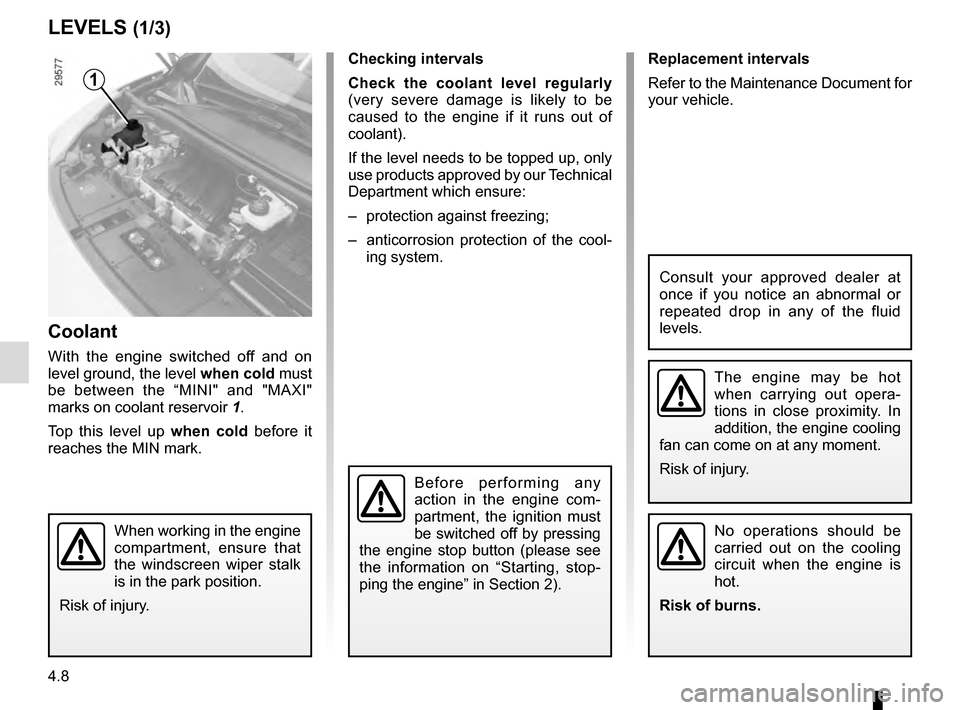
4.8
Replacement intervals
Refer to the Maintenance Document for
your vehicle.
Checking intervals
Check the coolant level regularly
(very severe damage is likely to be
caused to the engine if it runs out of
coolant).
If the level needs to be topped up, only
use products approved by our Technical
Department which ensure:
– protection against freezing;
– anticorrosion protection of the cool- ing system.
LEVELS (1/3)
Coolant
With the engine switched off and on
level ground, the level when cold must
be between the “MINI" and "MAXI"
marks on coolant reservoir 1.
Top this level up when cold before it
reaches the MIN mark.
No operations should be
carried out on the cooling
circuit when the engine is
hot.
Risk of burns.
Consult your approved dealer at
once if you notice an abnormal or
repeated drop in any of the fluid
levels.
The engine may be hot
when carrying out opera-
tions in close proximity. In
addition, the engine cooling
fan can come on at any moment.
Risk of injury.
1
When working in the engine
compartment, ensure that
the windscreen wiper stalk
is in the park position.
Risk of injury.
Before performing any
action in the engine com-
partment, the ignition must
be switched off by pressing
the engine stop button (please see
the information on “Starting, stop-
ping the engine” in Section 2).
Page 192 of 270
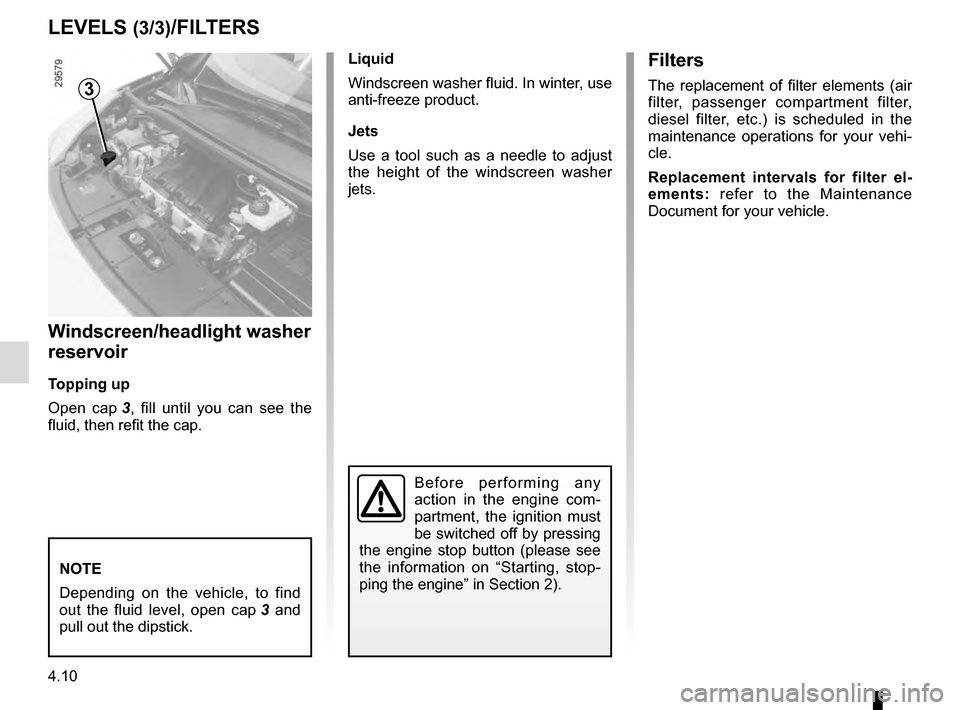
4.10
LEVELS (3/3)/FILTERS
Windscreen/headlight washer
reservoir
Topping up
Open cap 3, fill until you can see the
fluid, then refit the cap. Liquid
Windscreen washer fluid. In winter, use
anti-freeze product.
Jets
Use a tool such as a needle to adjust
the height of the windscreen washer
jets.
NOTE
Depending on the vehicle, to find
out the fluid level, open cap
3 and
pull out the dipstick.
Filters
The replacement of filter elements (air
filter, passenger compartment filter,
diesel filter, etc.) is scheduled in the
maintenance operations for your vehi-
cle.
Replacement intervals for filter el-
ements: refer to the Maintenance
Document for your vehicle.3
Before performing any
action in the engine com-
partment, the ignition must
be switched off by pressing
the engine stop button (please see
the information on “Starting, stop-
ping the engine” in Section 2).
Page 196 of 270
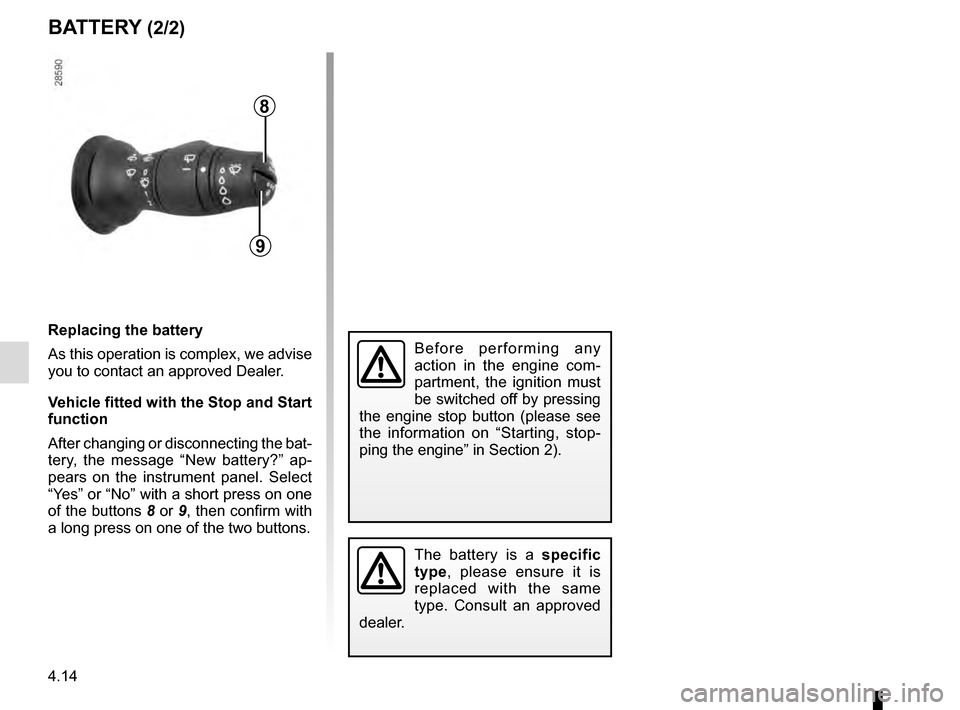
4.14
Replacing the battery
As this operation is complex, we advise
you to contact an approved Dealer.
Vehicle fitted with the Stop and Start
function
After changing or disconnecting the bat-
tery, the message “New battery?” ap-
pears on the instrument panel. Select
“Yes” or “No” with a short press on one
of the buttons 8 or 9, then confirm with
a long press on one of the two buttons.
8
9
BATTERY (2/2)
The battery is a specific
type, please ensure it is
replaced with the same
type. Consult an approved
dealer.
Before performing any
action in the engine com-
partment, the ignition must
be switched off by pressing
the engine stop button (please see
the information on “Starting, stop-
ping the engine” in Section 2).
Page 216 of 270
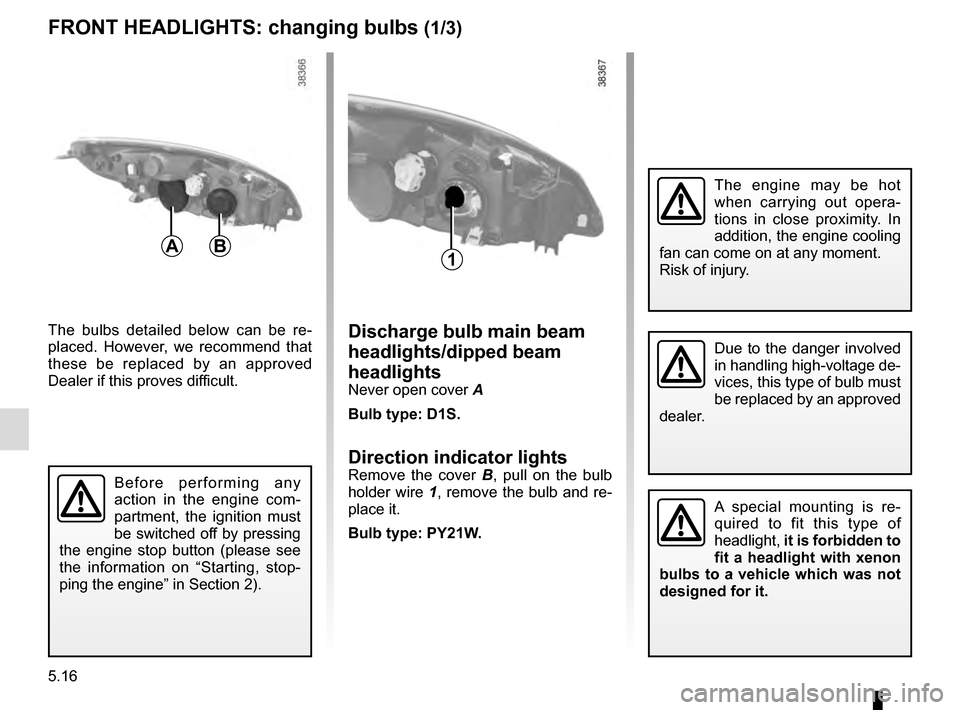
5.16
FRONT HEADLIGHTS: changing bulbs (1/3)
A special mounting is re-
quired to fit this type of
headlight, it is forbidden to
fit a headlight with xenon
bulbs to a vehicle which was not
designed for it.
Due to the danger involved
in handling high-voltage de-
vices, this type of bulb must
be replaced by an approved
dealer.Discharge bulb main beam
headlights/dipped beam
headlights
Never open cover A
Bulb type: D1S.
Direction indicator lightsRemove the cover B , pull on the bulb
holder wire 1, remove the bulb and re-
place it.
Bulb type: PY21W.
The engine may be hot
when carrying out opera-
tions in close proximity. In
addition, the engine cooling
fan can come on at any moment.
Risk of injury.
The bulbs detailed below can be re-
placed. However, we recommend that
these be replaced by an approved
Dealer if this proves difficult.
AB1
Before performing any
action in the engine com-
partment, the ignition must
be switched off by pressing
the engine stop button (please see
the information on “Starting, stop-
ping the engine” in Section 2).
Page 227 of 270
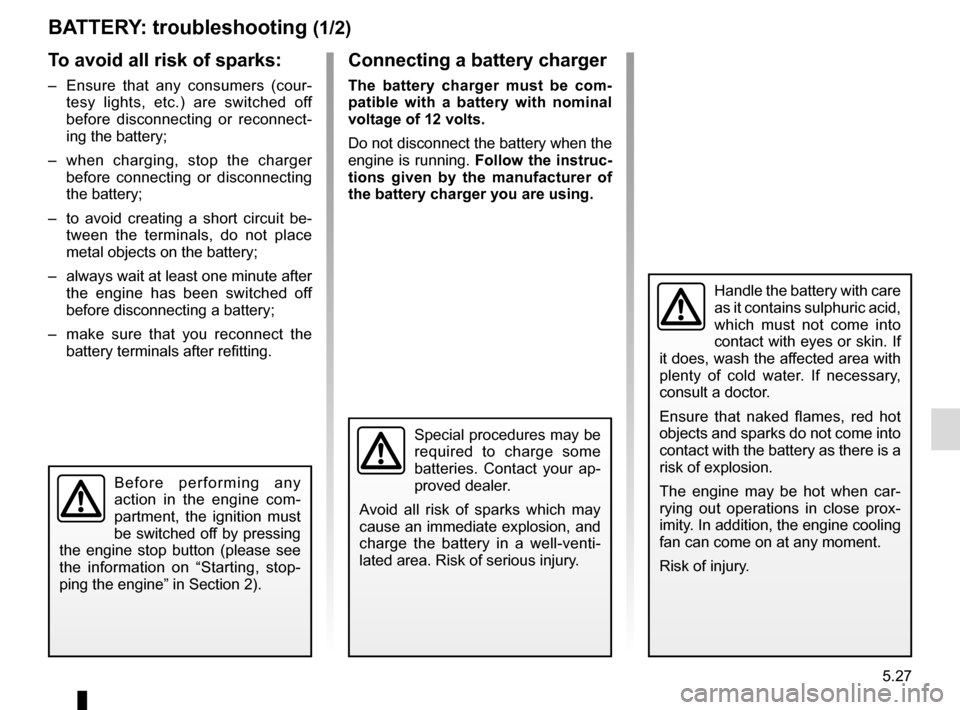
5.27
BATTERY: troubleshooting (1/2)
To avoid all risk of sparks:
– Ensure that any consumers (cour-tesy lights, etc.) are switched off
before disconnecting or reconnect-
ing the battery;
– when charging, stop the charger before connecting or disconnecting
the battery;
– to avoid creating a short circuit be- tween the terminals, do not place
metal objects on the battery;
– always wait at least one minute after the engine has been switched off
before disconnecting a battery;
– make sure that you reconnect the battery terminals after refitting.
Connecting a battery charger
The battery charger must be com-
patible with a battery with nominal
voltage of 12 volts.
Do not disconnect the battery when the
engine is running. Follow the instruc-
tions given by the manufacturer of
the battery charger you are using.
Special procedures may be
required to charge some
batteries. Contact your ap-
proved dealer.
Avoid all risk of sparks which may
cause an immediate explosion, and
charge the battery in a well-venti-
lated area. Risk of serious injury.
Handle the battery with care
as it contains sulphuric acid,
which must not come into
contact with eyes or skin. If
it does, wash the affected area with
plenty of cold water. If necessary,
consult a doctor.
Ensure that naked flames, red hot
objects and sparks do not come into
contact with the battery as there is a
risk of explosion.
The engine may be hot when car-
rying out operations in close prox-
imity. In addition, the engine cooling
fan can come on at any moment.
Risk of injury.
Before performing any
action in the engine com-
partment, the ignition must
be switched off by pressing
the engine stop button (please see
the information on “Starting, stop-
ping the engine” in Section 2).
Page 228 of 270
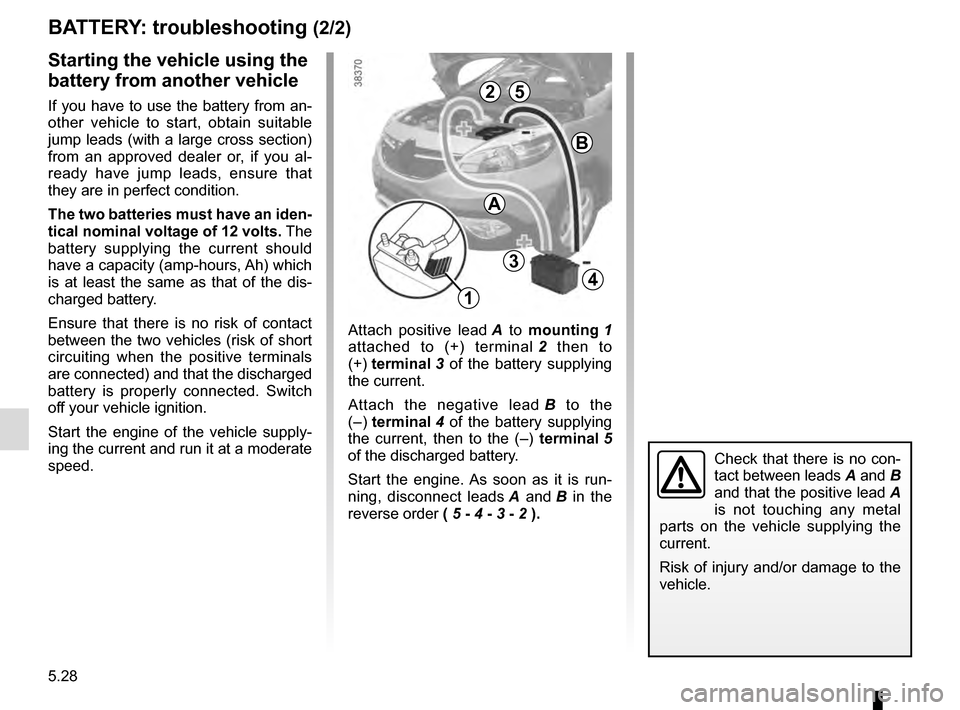
5.28
Starting the vehicle using the
battery from another vehicle
If you have to use the battery from an-
other vehicle to start, obtain suitable
jump leads (with a large cross section)
from an approved dealer or, if you al-
ready have jump leads, ensure that
they are in perfect condition.
The two batteries must have an iden-
tical nominal voltage of 12 volts. The
battery supplying the current should
have a capacity (amp-hours, Ah) which
is at least the same as that of the dis-
charged battery.
Ensure that there is no risk of contact
between the two vehicles (risk of short
circuiting when the positive terminals
are connected) and that the discharged
battery is properly connected. Switch
off your vehicle ignition.
Start the engine of the vehicle supply-
ing the current and run it at a moderate
speed.
BATTERY: troubleshooting (2/2)
Attach positive lead A to mounting 1
attached to (+) terminal 2 then to
(+) terminal 3 of the battery supplying
the current.
Attach the negative lead B to the
(– ) terminal 4 of the battery supplying
the current, then to the (–) terminal 5
of the discharged battery.
Start the engine. As soon as it is run-
ning, disconnect leads A and B in the
reverse order ( 5 - 4 - 3 - 2 ).
Check that there is no con-
tact between leads A and B
and that the positive lead A
is not touching any metal
parts on the vehicle supplying the
current.
Risk of injury and/or damage to the
vehicle.
2
3
4
5
A
B
1
Page 231 of 270
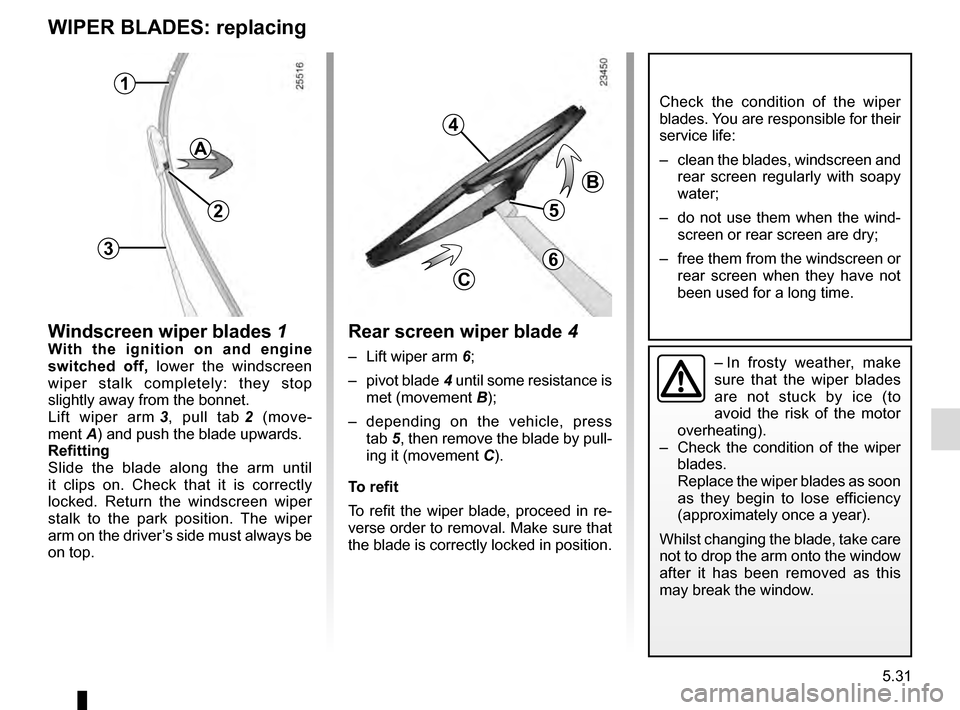
5.31
WIPER BLADES: replacing
Windscreen wiper blades 1With the ignition on and engine
switched off, lower the windscreen
wiper stalk completely: they stop
slightly away from the bonnet.
Lift wiper arm 3, pull tab 2 (move-
ment A) and push the blade upwards.
Refitting
Slide the blade along the arm until
it clips on. Check that it is correctly
locked. Return the windscreen wiper
stalk to the park position. The wiper
arm on the driver’s side must always be
on top.– In frosty weather, make
sure that the wiper blades
are not stuck by ice (to
avoid the risk of the motor
overheating).
– Check the condition of the wiper
blades.
Replace the wiper blades as soon
as they begin to lose efficiency
(approximately once a year).
Whilst changing the blade, take care
not to drop the arm onto the window
after it has been removed as this
may break the window.
1
2
3
Check the condition of the wiper
blades. You are responsible for their
service life:
– clean the blades, windscreen and rear screen regularly with soapy
water;
– do not use them when the wind- screen or rear screen are dry;
– free them from the windscreen or rear screen when they have not
been used for a long time.
Rear screen wiper blade 4
– Lift wiper arm 6;
– pivot blade 4 until some resistance is
met (movement B);
– depending on the vehicle, press tab 5, then remove the blade by pull-
ing it (movement C).
To refit
To refit the wiper blade, proceed in re-
verse order to removal. Make sure that
the blade is correctly locked in position.
4
5
B
C
A
6
Page 236 of 270
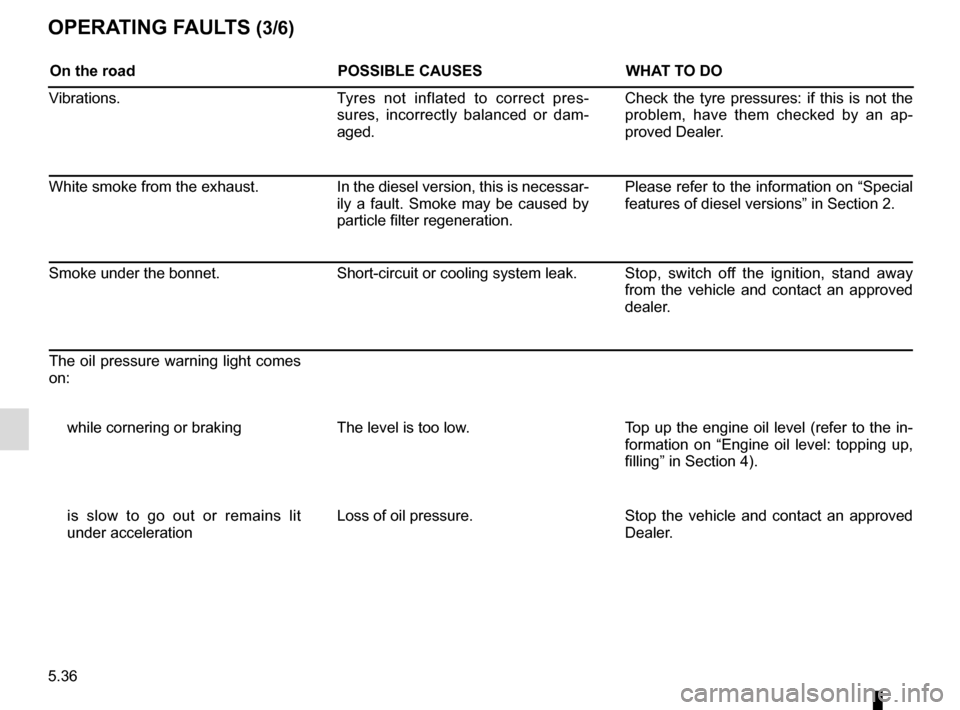
5.36
OPERATING FAULTS (3/6)
On the roadPOSSIBLE CAUSESWHAT TO DO
Vibrations. Tyres not inflated to correct pres-
sures, incorrectly balanced or dam-
aged. Check the tyre pressures: if this is not the
problem, have them checked by an ap-
proved Dealer.
White smoke from the exhaust. In the diesel version, this is necessar-
ily a fault. Smoke may be caused by
particle filter regeneration. Please refer to the information on “Special
features of diesel versions” in Section 2.
Smoke under the bonnet. Short-circuit or cooling system leak. Stop, switch off the ignition, stand away
from the vehicle and contact an approved
dealer.
The oil pressure warning light comes
on: while cornering or braking The level is too low. Top up the engine oil level (refer to the in-
formation on “Engine oil level: topping up,
filling” in Section 4).
is slow to go out or remains lit
under acceleration Loss of oil pressure.
Stop the vehicle and contact an approved
Dealer.
Page 266 of 270
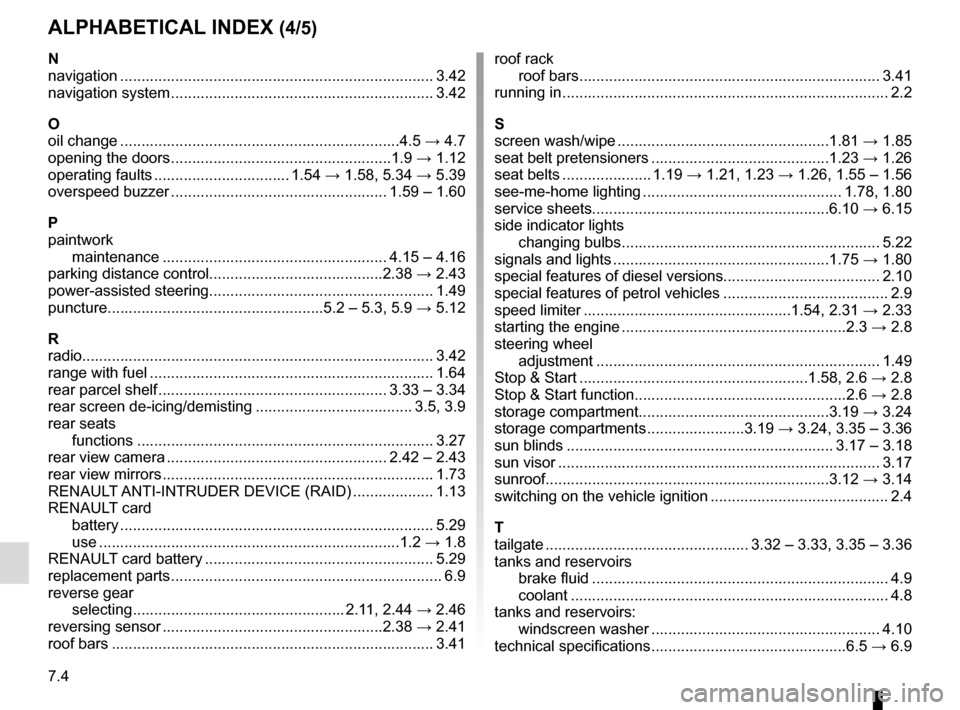
7.4
ALPHABETICAL INDEX (4/5)
N
navigation .............................................................\
............. 3.42
navigation system .............................................................. 3.42
O
oil change ..................................................................4.5 → 4.7
opening the doors ....................................................1.9 → 1.12
operating faults ................................ 1.54 → 1.58, 5.34 → 5.39
overspeed buzzer ................................................... 1.59 – 1.60
P
paintwork maintenance ..................................................... 4.15 – 4.16
parking distance control.........................................2.38 → 2.43
power-assisted steering.................................................\
.... 1.49
puncture...................................................5.2 – 5.3,\
5.9 → 5.12
R
radio...................................................................\
................ 3.42
range with fuel ................................................................... 1.64
rear parcel shelf ...................................................... 3.33 – 3.34
rear screen de-icing/demisting ..................................... 3.5, 3.9
rear seats functions ..............................................................\
........ 3.27
rear view camera .................................................... 2.42 – 2.43
rear view mirrors ................................................................ 1.73
RENAULT ANTI-INTRUDER DEVICE (RAID) ................... 1.13
RENAULT card battery ................................................................\
.......... 5.29
use ....................................................................\
...1.2 → 1.8
RENAULT card battery ...................................................... 5.29
replacement parts ................................................................ 6.9
reverse gear selecting .................................................. 2.11, 2.44 → 2.46
reversing sensor ....................................................2.38 → 2.41
roof bars ........................................................................\
.... 3.41 roof rack
roof bars ....................................................................... 3.41
running in ........................................................................\
..... 2.2
S
screen wash/wipe ..................................................1.81 → 1.85
seat belt pretensioners ..........................................1.23 → 1.26
seat belts ..................... 1.19 → 1.21, 1.23 → 1.26, 1.55 – 1.56
see-me-home lighting ............................................... 1.78, 1.80
service sheets........................................................6.\
10 → 6.15
side indicator lights changing bulbs ............................................................. 5.22
signals and lights ...................................................1.75 → 1.80
special features of diesel versions.....................................\
2.10
special features of petrol vehicles ....................................... 2.9
speed limiter .................................................1.54, 2.31 → 2.33
starting the engine .....................................................2.3 → 2.8
steering wheel adjustment .............................................................\
...... 1.49
Stop & Start ......................................................1.58, 2.6 → 2.8
Stop & Start function..................................................2.6 → 2.8
storage compartment.............................................3.19 → 3.24
storage compartments .......................3.19 → 3.24, 3.35 – 3.36
sun blinds ............................................................... 3.17 – 3.18
sun visor ........................................................................\
.... 3.17
sunroof.................................................................\
..3.12 → 3.14
switching on the vehicle ignition .......................................... 2.4
T
tailgate ................................................ 3.32 – 3.33, 3.35 – 3.36
tanks and reservoirs brake fluid ...................................................................... 4.9
coolant ................................................................\
........... 4.8
tanks and reservoirs: windscreen washer ...................................................... 4.10
technical specifications ..............................................6.5 → 6.9